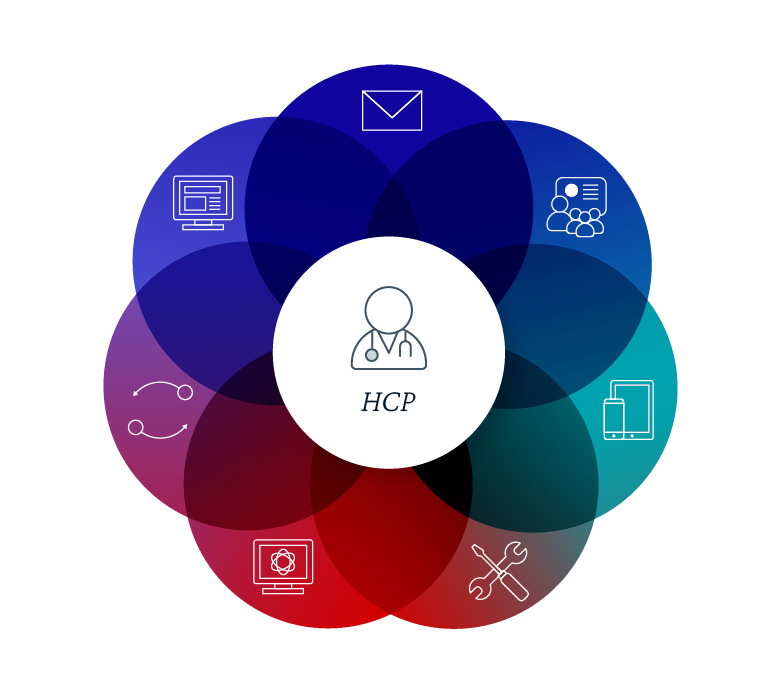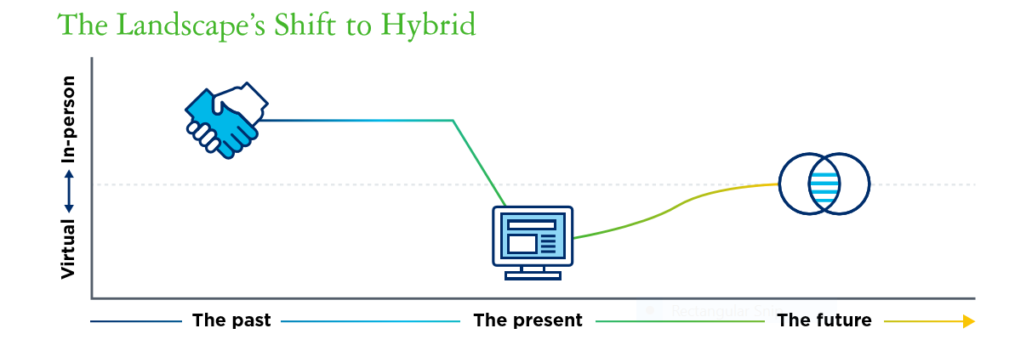
While new standard ways of reaching customers coalesce, here are 4 trends highlighting how Medical Affairs is being shaped by an omnichannel approach.
Concurrent Events
How do customer journeys align now that concurrent events are the new norm?
As we move into a world that has been informed by traditional behaviours and new ones that have emerged throughout the pandemic, companies will now be tasked with designing consistently engaging and educational experiences for both in-person and virtual user journeys – particularly in the case of events and congresses.

The term concurrent events has emerged as we move into a hybrid state of channels, challenging teams to build experiences for both virtual and in-person user types. Teams that successfully bridge the two and create tactics that can be accessed from multiple channels without compromising experience on either end, will emerge as the leaders in events and be able to reap the benefits each channel provides.
As we move towards this hybrid world, designing with a user-centric lens remains as important as ever to ensure business goals, key educational objectives, and user experiences are aligned and achieved across the parallel user journeys.
We see a possible future of hub-location events for global congress events. These hubs located around the world with a virtual hub included, allow for smaller groups of people to meet while limiting the need for out-of-country travel. In-person attendees are still able to network and meet affiliates locally, while virtual attendees remain a part of the live event through a connected and synchronized event management technology stack. In this world, in-person tactics are mirrored as HTML micro experiences creating as close to a consistent event as possible and benefiting from post-event re-use and access that comes with digital tools. All the while, each hub instance tracks metrics which is aggregated and consolidated into a single analytics dashboard for easy analysis and tracking.
Interactive Social Media
The Social media accounts of thought leaders and influencers can get your messages in front of HCPs in unprecedented ways. Companies will need to stand out from the crowd with posts that can grab attention and hold it to make memorable moments. We see social becoming a playground for all content types – no longer only text, images, or videos, but accommodating Augmented Reality (AR), commerce, browser viewers, and more. Embedding interactive media on social platforms allows users to participate and engage with a post rather than simply viewing or reading it.
In a world of constant streams of content, users prefer to engage with visual content to text (68% preferred images, 50% preferred videos, and 30% enjoyed text-based posts – Sprout Social, 2021). Taking these user preferences and coupled with our knowledge that self-directed, interactive learning can improve learning performance and satisfaction, leads us to believe interactive social is a ripe new channel ready to make a splash in an omnichannel strategy (AJDE, 2005).
With 3D model embedding technology already available in many social platforms and used by INVIVO, we see a future where modular 3D asset libraries become the standard to break down the silo between promotion and tactic development. This future is close and even possible today.
Using this omnichannel asset creation approach, we can serve users an interactive 3D model embedded in their news feed to catch and grab their attention, after rotating and scaling the model the user can continue their journey by clicking out to the full experience where that same (and more!) models live in the full experience of HTML, web AR, or 360 video. These models already created for the core learning tool can now be leveraged as promotion unlike any other, generating more reach and increasing your ROI.
Understanding how and where users are accessing your content from will impact the design of these tools, but equally as important designing these with an asset-modular approach ensures models are stretched further.
When a tweet with a 3D interactive model from Sketchfab is viewed within the Twitter platform, you can manipulate the model without leaving for a new tab. Here from our site, it will launch the model in a new tab.
Interactive Video
Pharma has been using rich image-based media on websites and in PowerPoint to promote and educate for years.
What we haven’t seen as often is the ability for linking and interactivity to be built directly into animations. Taking cues and inspiration from the newly released shoppable video features by YouTube and interactive music videos, content can now be deep linked to supportive research or sites or even determine the narrative of the animation on screen. Putting the end user in the decision seat creates curiosity and encourages exploration while effectively continuing the engagement loop and building an ecosystem of content that works together.
!["A TIME FOR BOLD NEW THINKING". Seemingly overnight, the industry underwent a digital transformation shifting legacy communication methods such as in-person meetings, peer-to-peer sessions, and congress events to virtual for the first time ever, disrupting your ability to connect with your HCP. [3 boxes] 1. +52% of meeting and event professionals are having both virtual and in-person events moving forward (1). 2. +65% of meetings with HCPs are held remotely post-pandemic (2). 3. +74% of HCPs think that scientific meetings should continue to be virtual or have a virtual component after the pandemic ends (3).](https://cdn.sanity.io/images/1ydgtmdy/production/813ac4226e6928541cdadd1d45a333a6f38ae95c-492x243.png?w=492&h=243&q=100&fit=max&auto=format)
Layering interactivity onto animations turns this media type from passive into active learning opportunities – an area INVIVO and Red Nucleus specializes in. We envision videos where mechanism of action (MOA) videos have built in branching story lines to paired videos of relevant patient stories, or offer a new, organized way to link resources and KOL opinions when presenting data in video format. The trend of short, bite-sized content is not going anywhere; now the focus is shifting to how we can bridge these content pieces together using links in a seamless way.
The emergence of technically-confident medical teams
As more pharmaceutical companies adopt and implement a technology ecosystem that is built for delivering an omnichannel experience, having teams that are comfortable working with these channels will be the differentiator between organizations.
Breaking down the silos between IT and medical affairs teams through collaborative communication, and empowering them with a comprehensive understanding of the ecosystem itself will become more important than ever. We see this cultural-shift evolving into a trend of an emerging technically-comfortable medical affairs team, where leads are equipped with the proper training and resources to successfully launch digital projects that seamlessly fit into the omnichannel ecosystem.
Equipping teams with best-in-class playbooks, project-specific checklists, and consistent resources to share with agencies on organizational and functional requirements positions these teams for success in fulfilling the omnichannel vision – while keeping IT teams happy. As a digitally-native agency INVIVO has accumulated these best-in-class practices of working with specific systems and channels, and understand the value that is held in these details. We see this trend emerging as channel-agnostic expert employees existing across every department, capable of running informed omnichannel campaigns effortlessly and using standardized functional resources to do so.
These trends are sweeping through the industry quickly as we shift out from a lockdown pandemic to a rapidly changing concurrent & hybrid model. Moving your medical affairs team to an omnichannel approach may sound complex, but it doesn’t have to be with experienced guidance. We invite you to download our Red Paper, Perspectives on Omnichannel: How to implement a winning strategy to learn more.
At Red Nucleus we take time to understand the current to solve for tomorrow; to stay ahead of the innovation forefront and build your future-ready solutions. Contact us today to continue the conversation.
References:
Nature; Scientists want virtual meetings to stay after the COVID pandemic; retrieved July 2021.
McKinsey & Company; The B2B digital inflection point: How sales have changed during COVID-19; retrieved May 2021
Sprout Social; 36 Essential social media marketing statistics to know for 2021; retrieved July 2021
The American Journal of Distance Education, 2005 – Taylor & Francis; Interactive multimedia-based e-learning: A study of effectiveness D Zhang; retrieved July 2021
